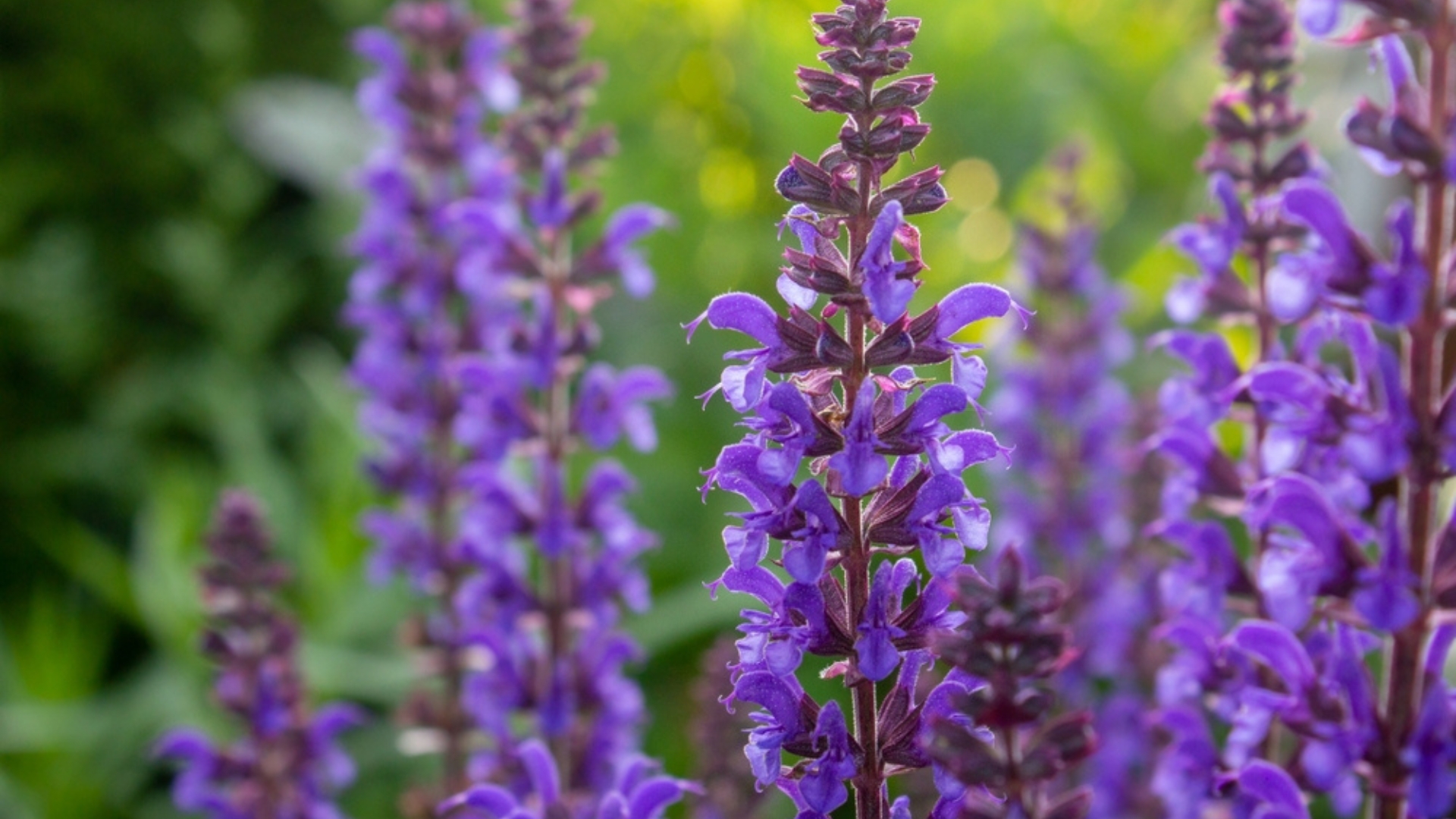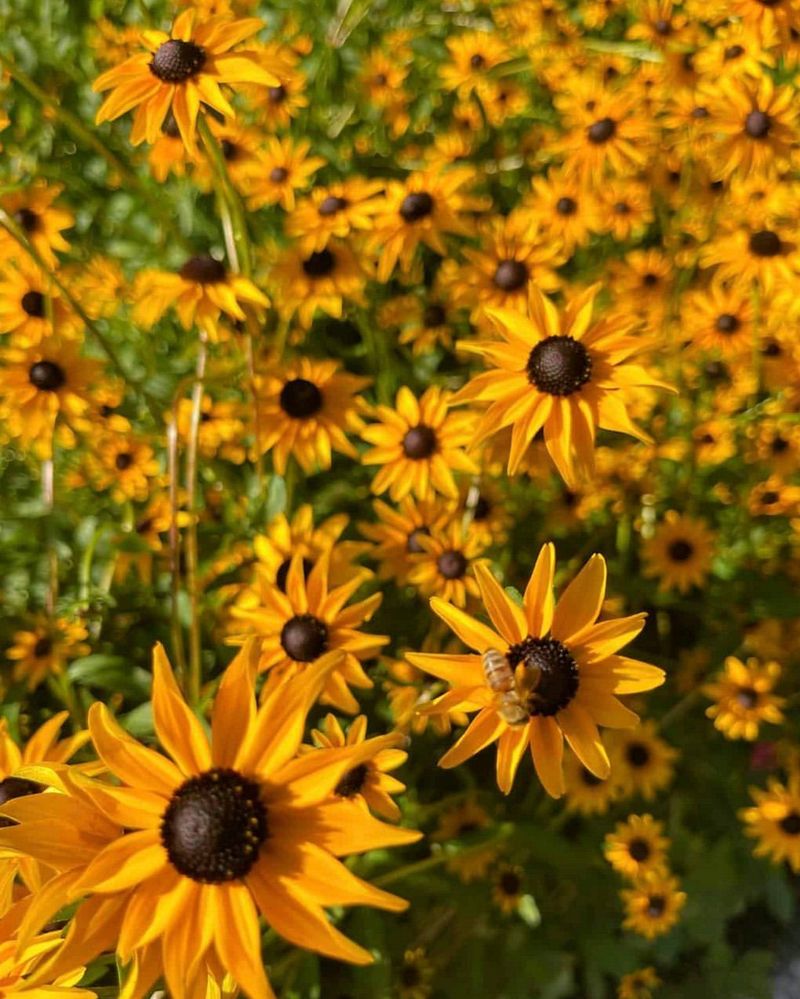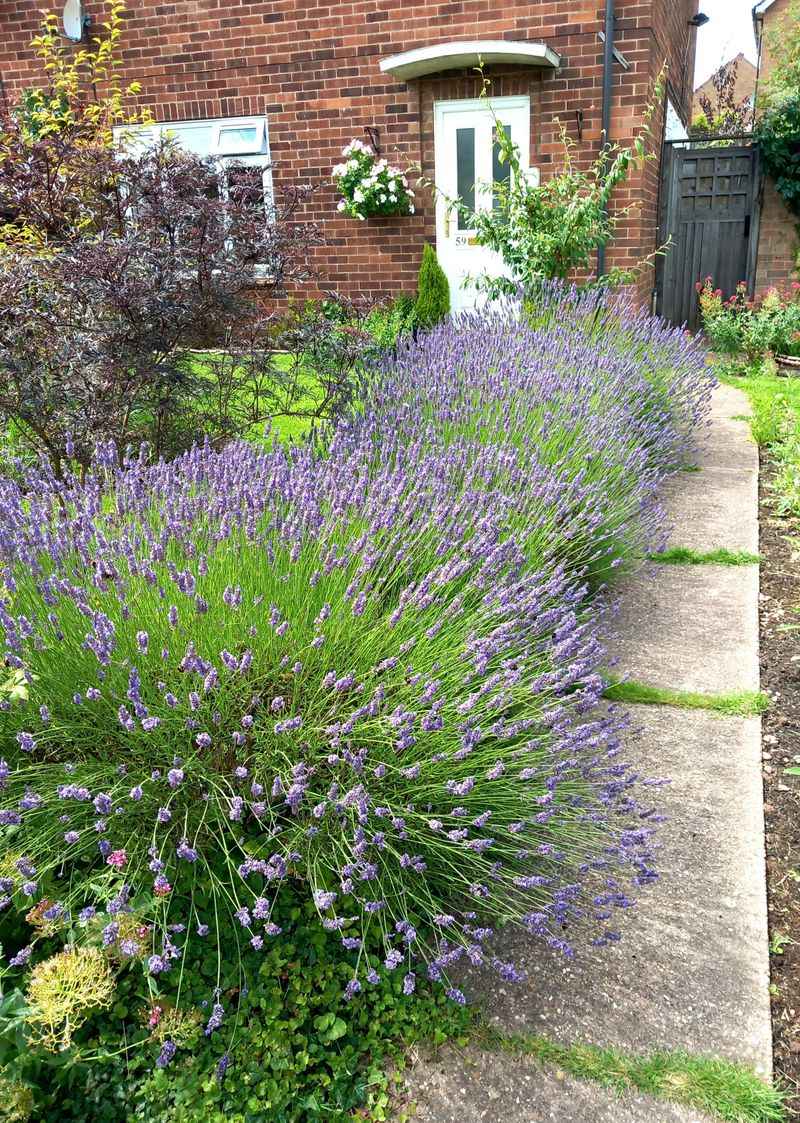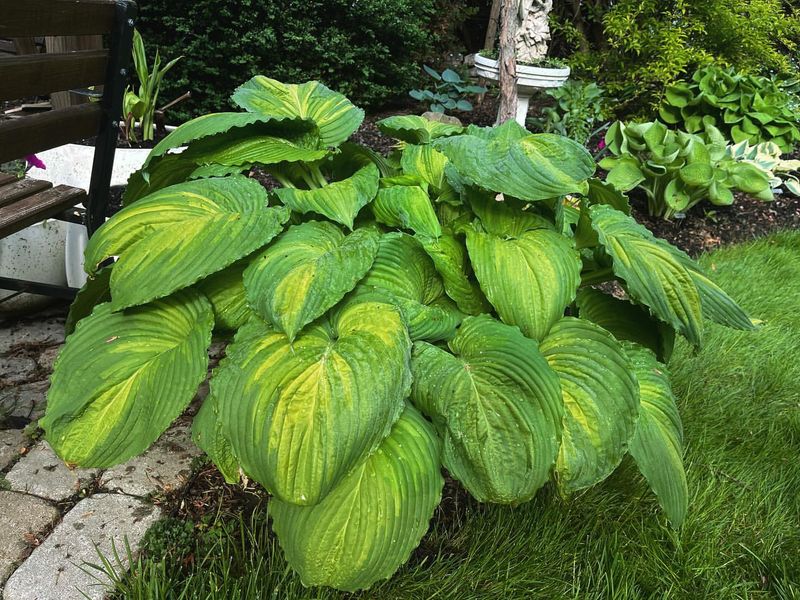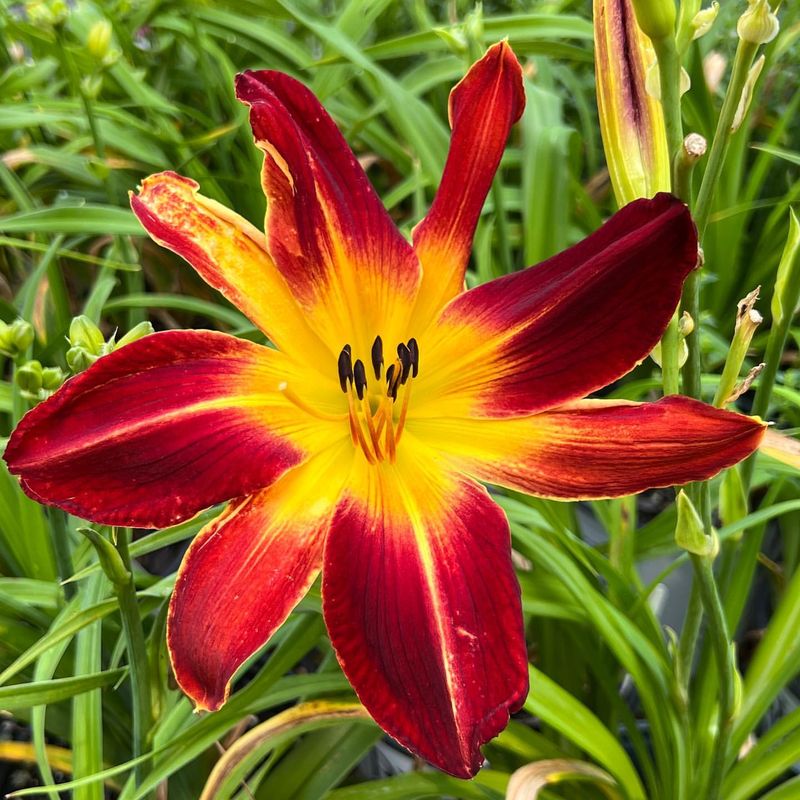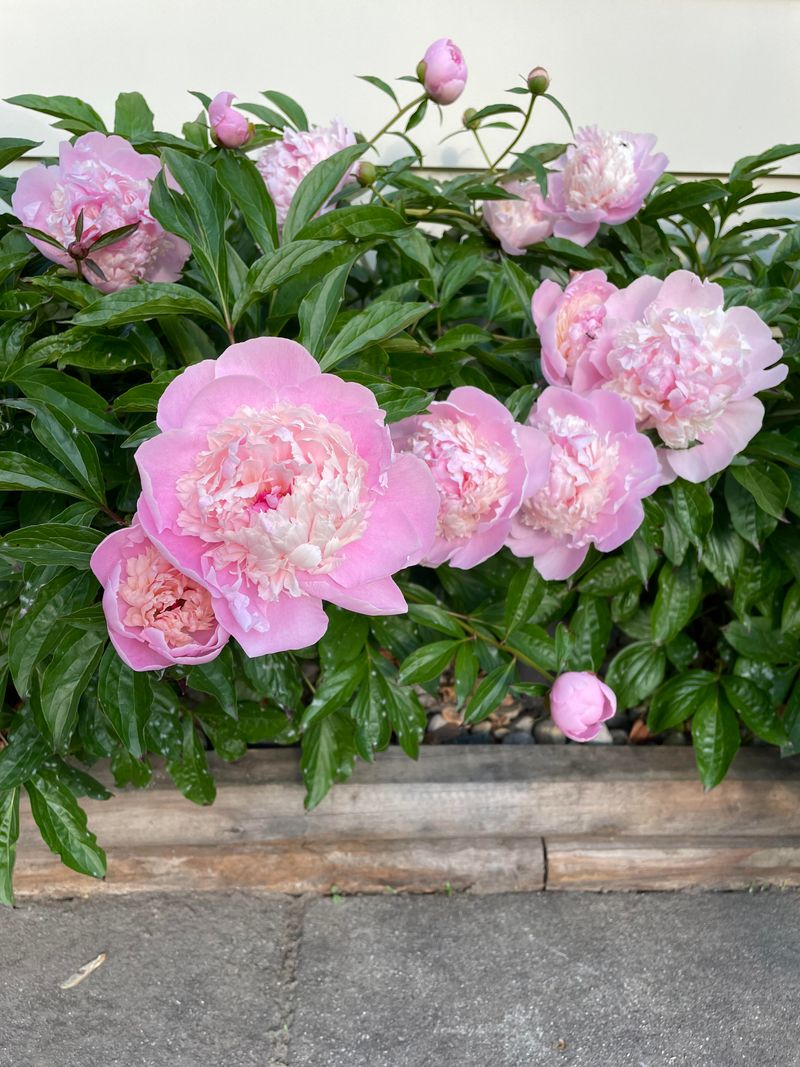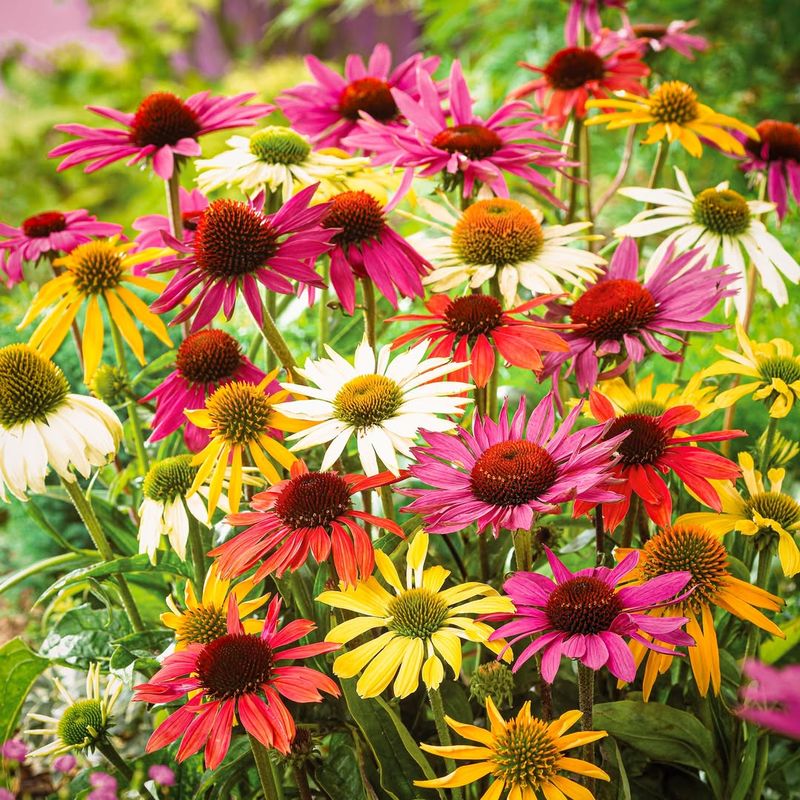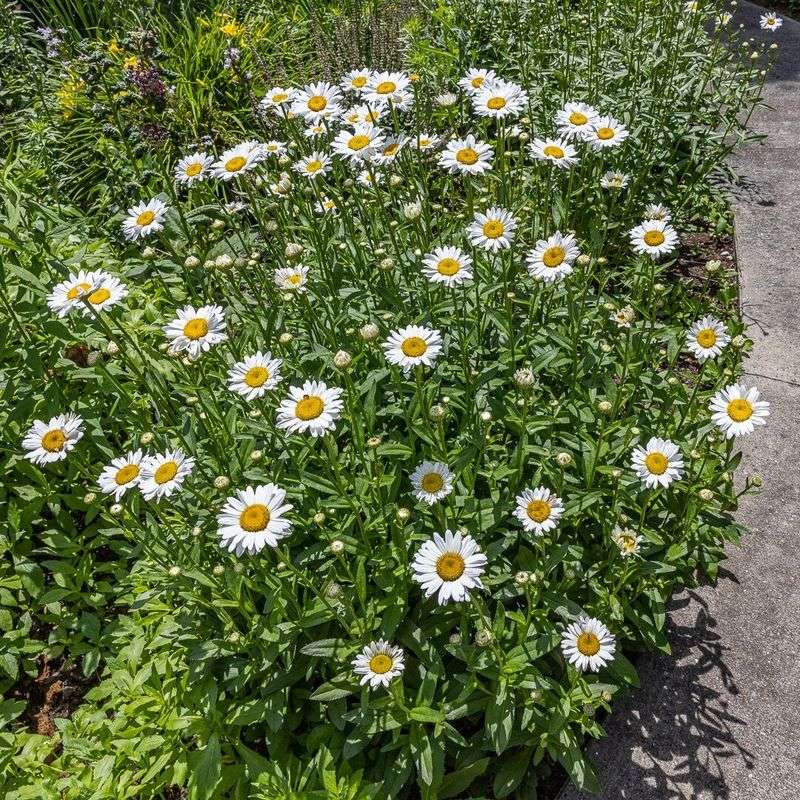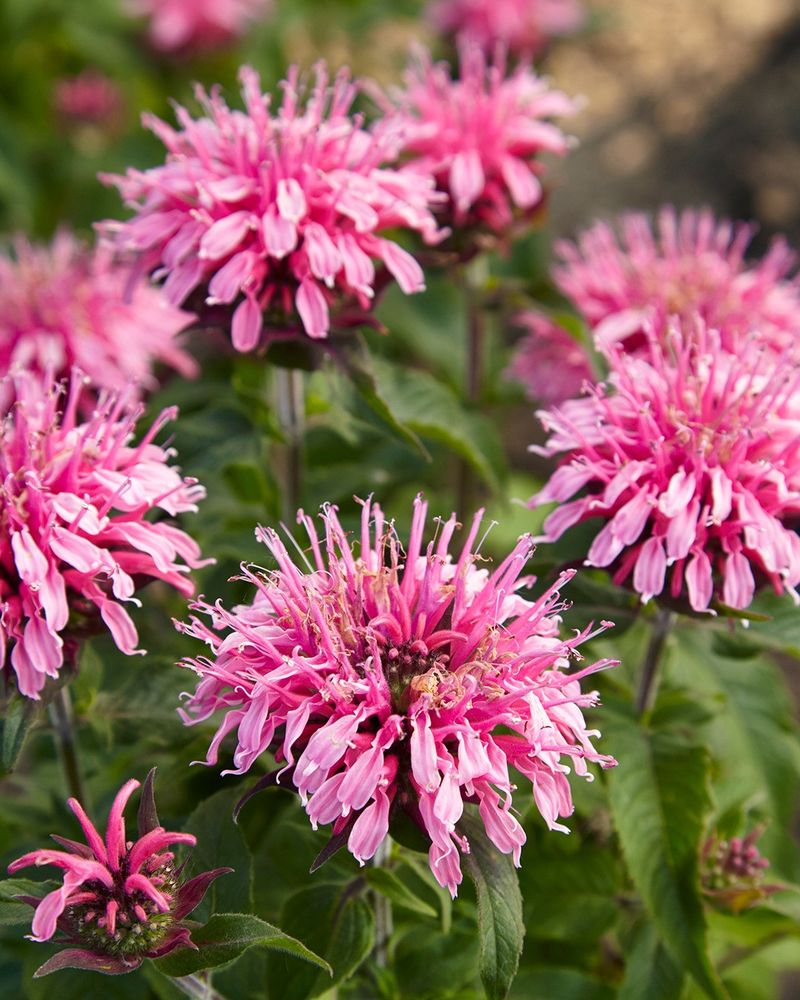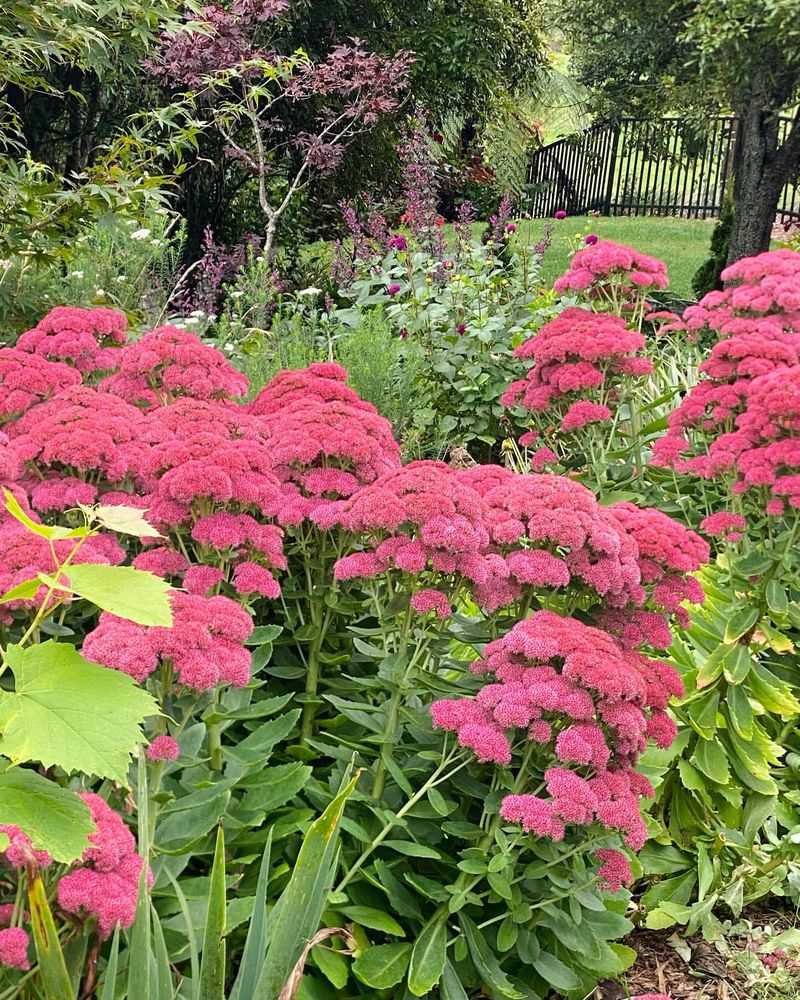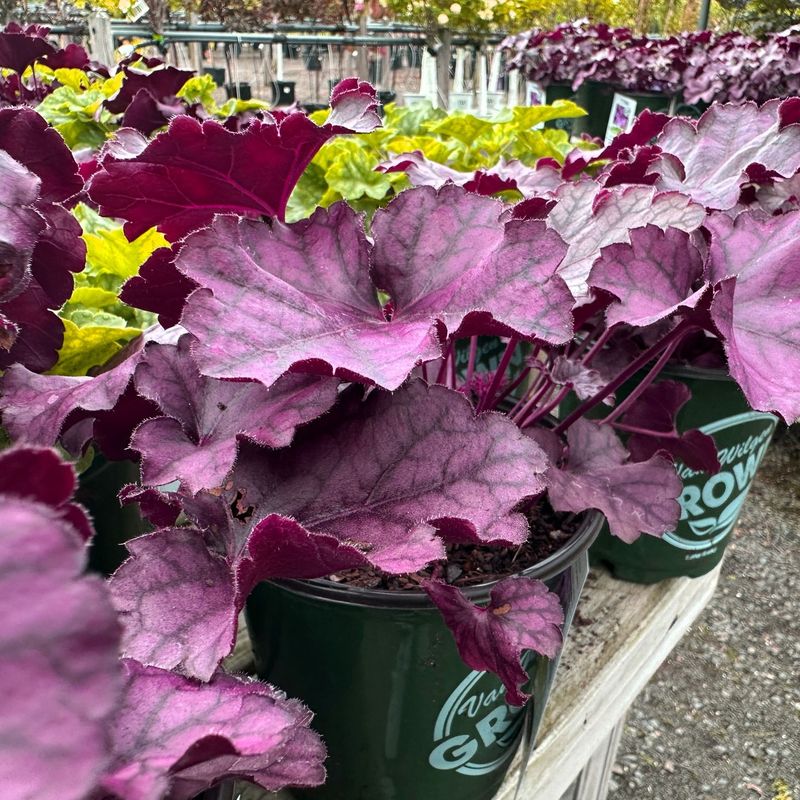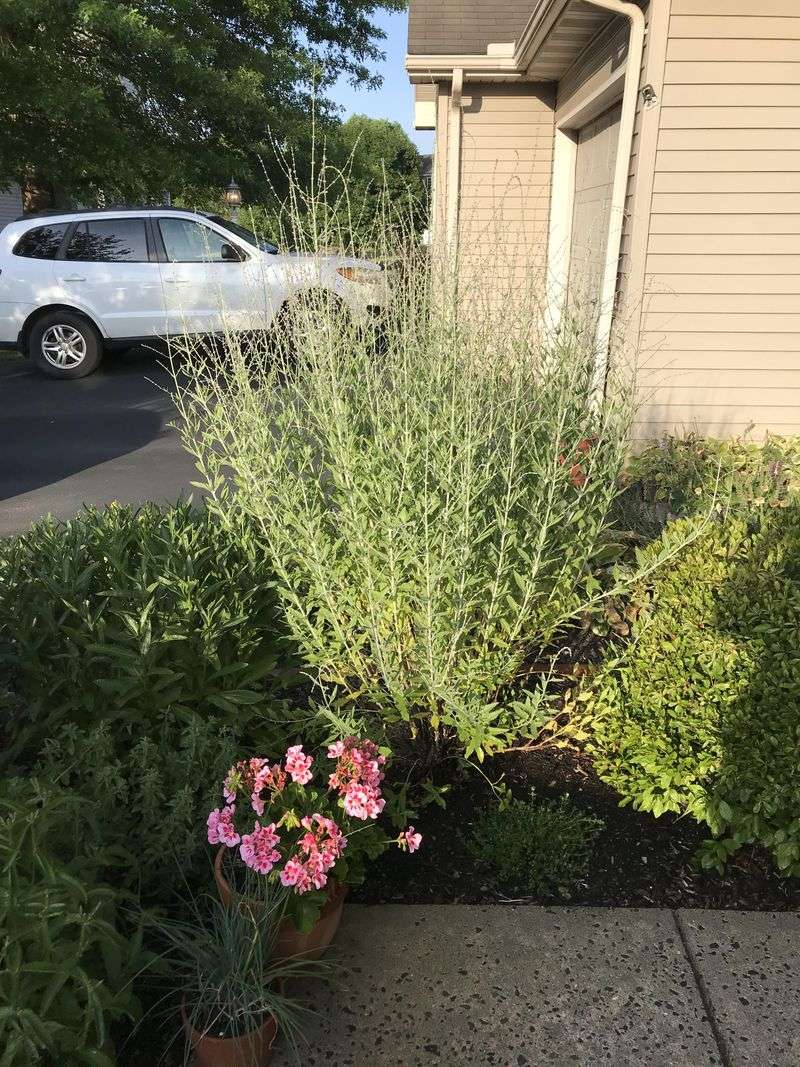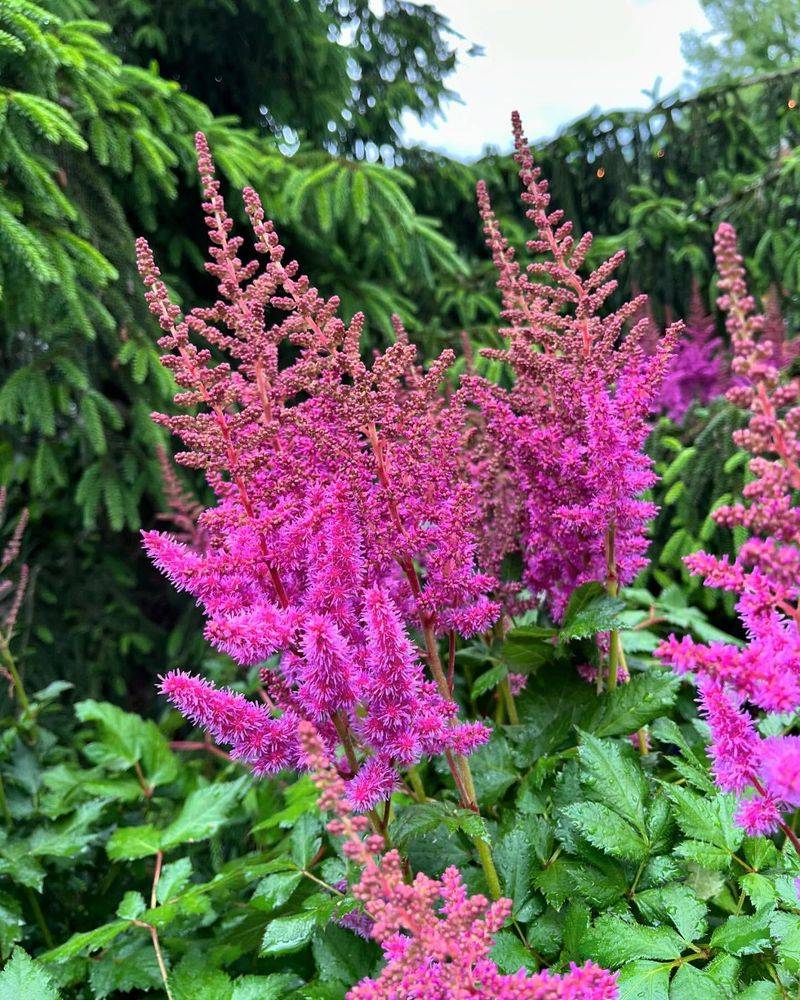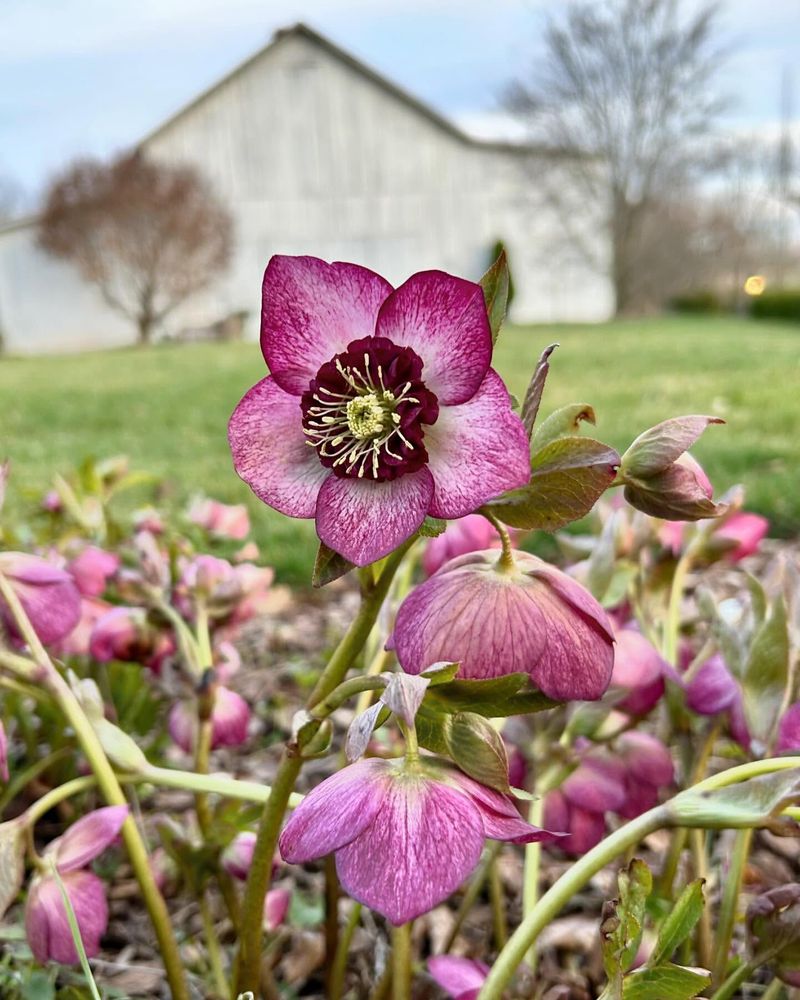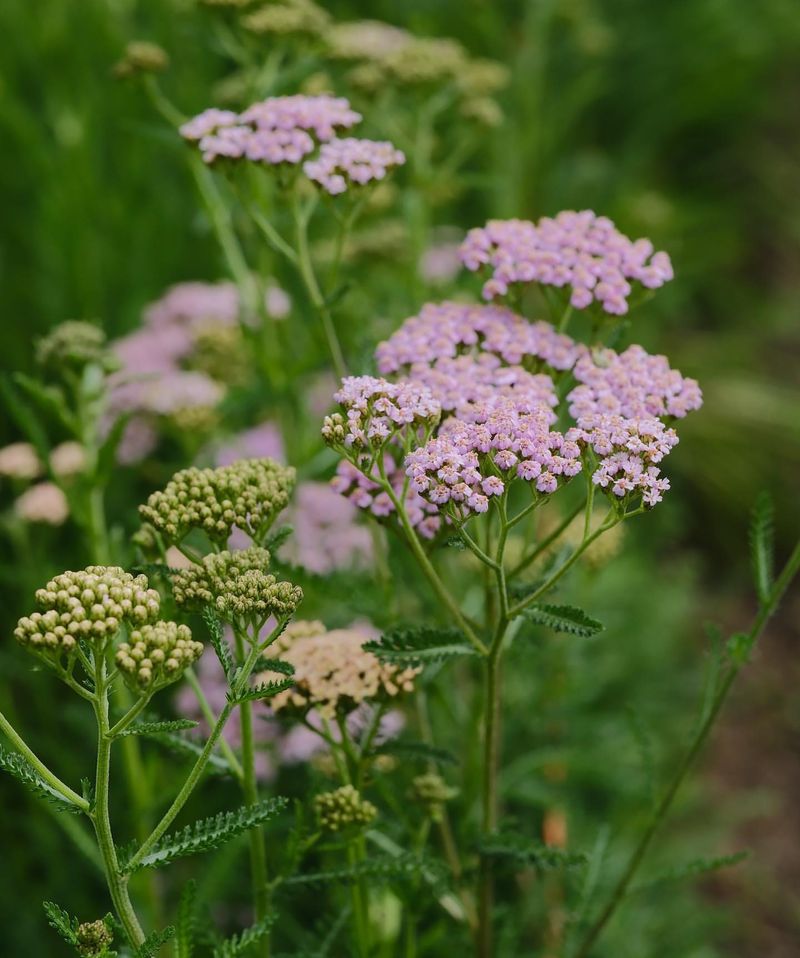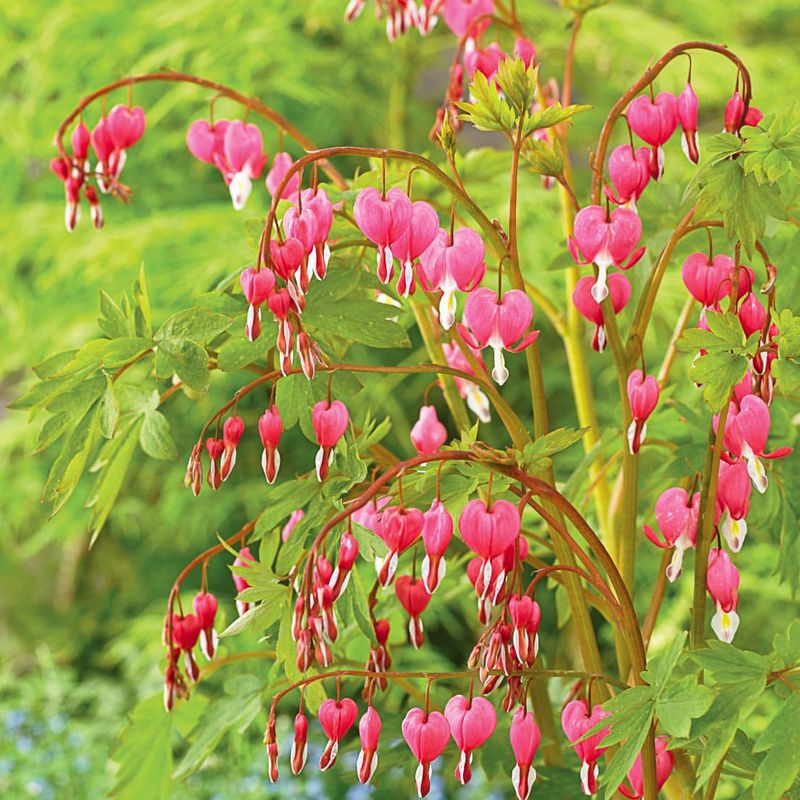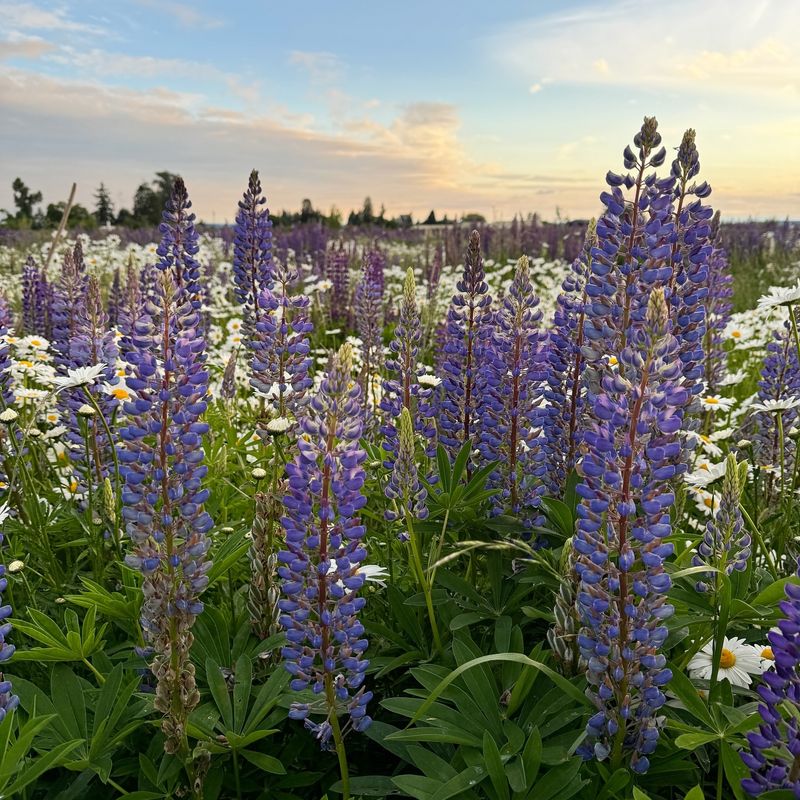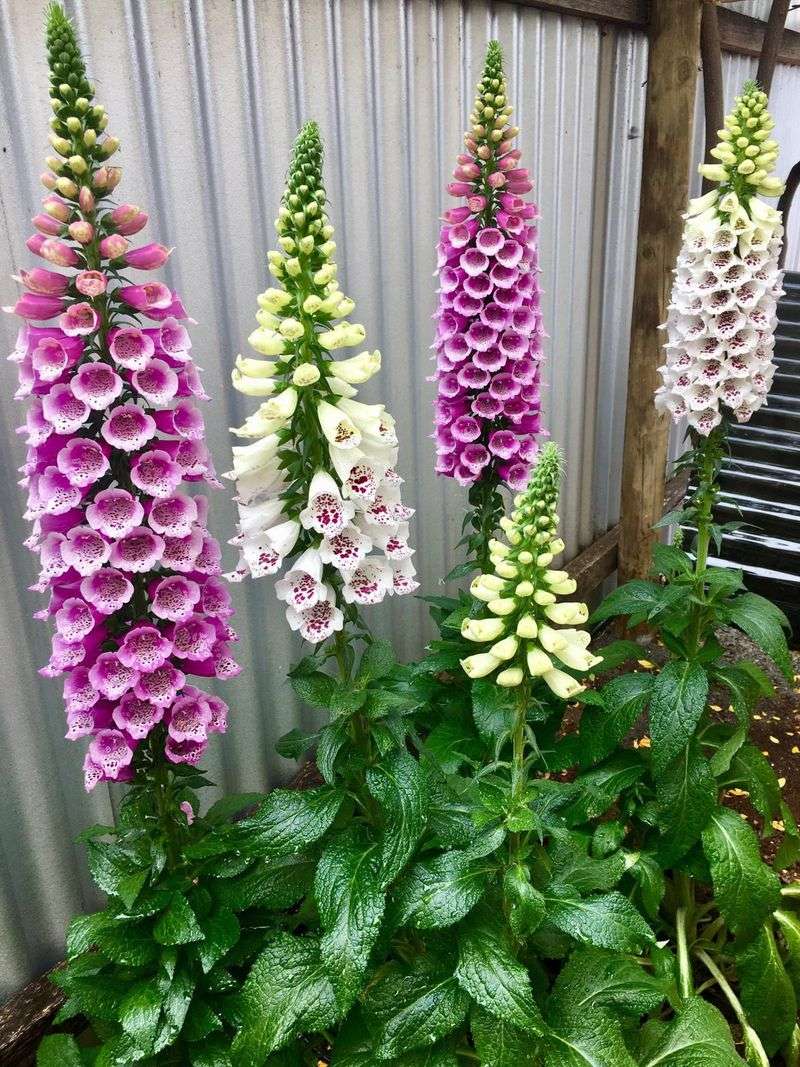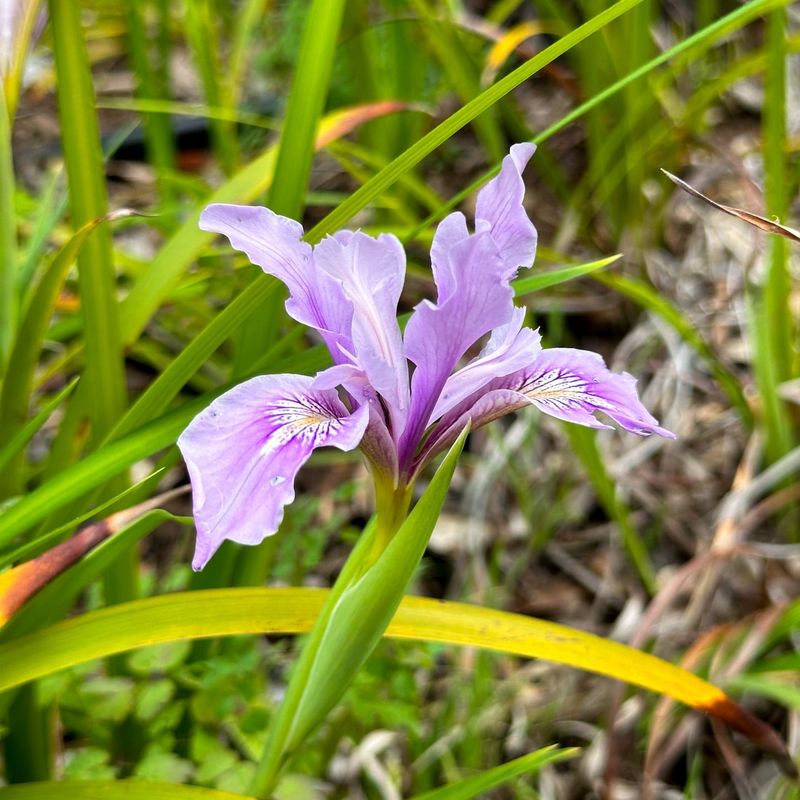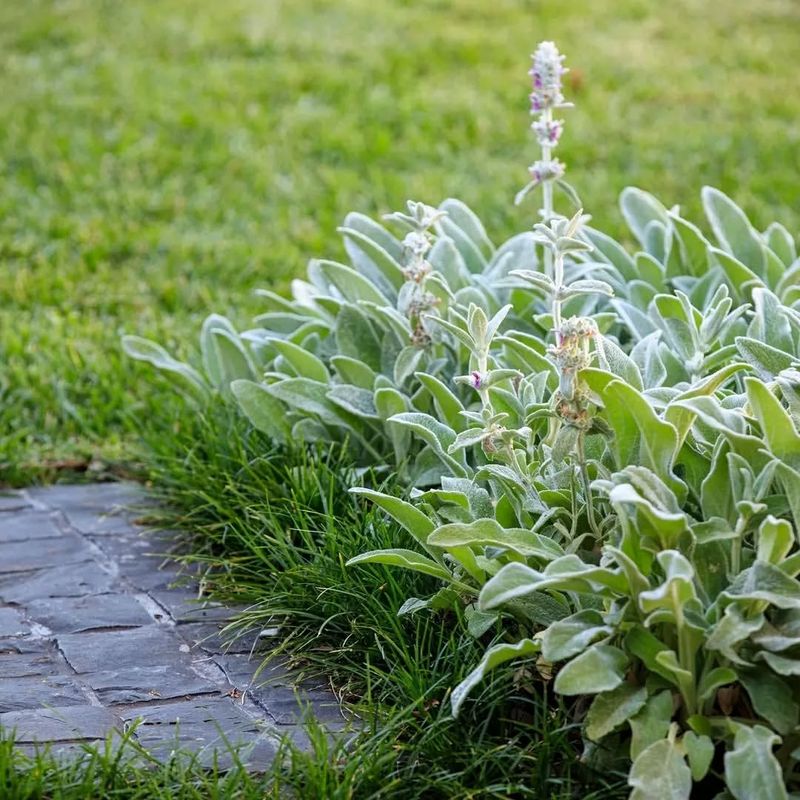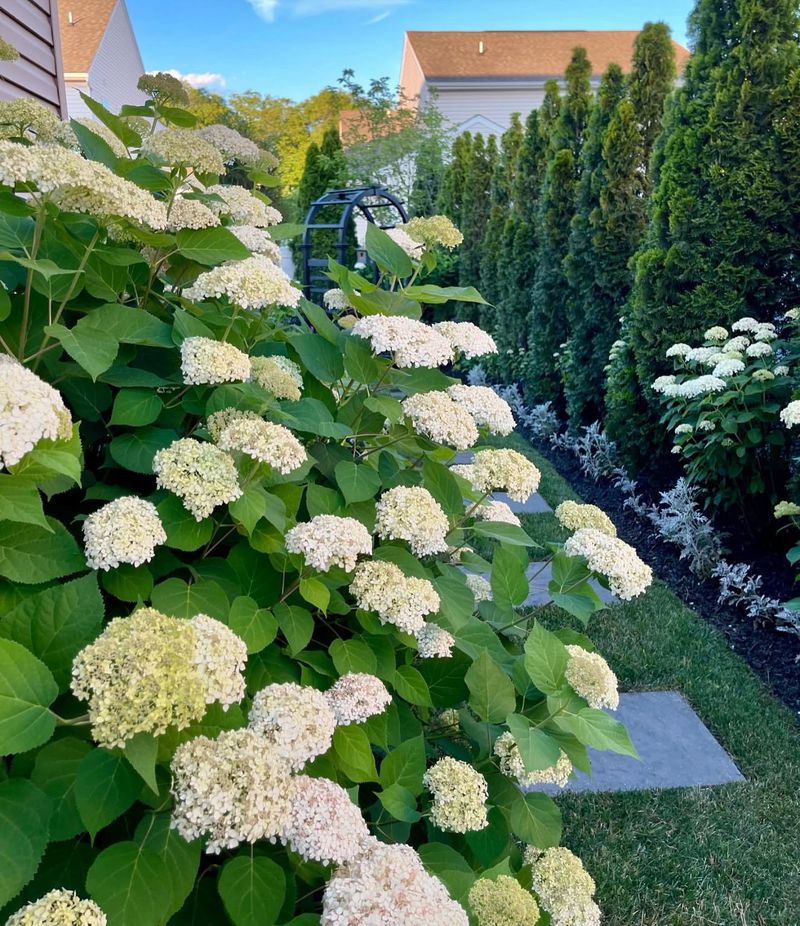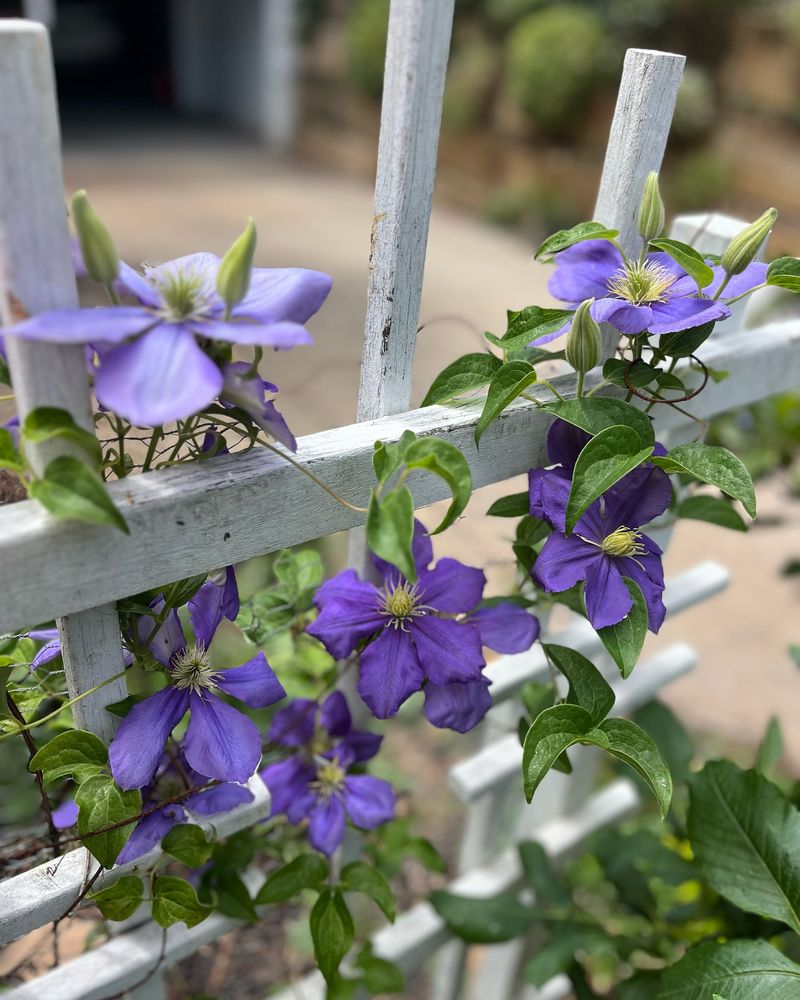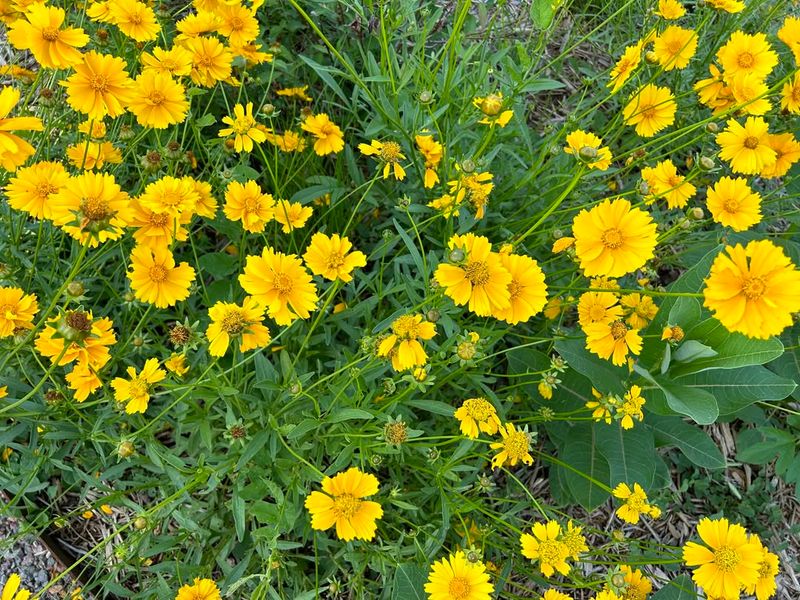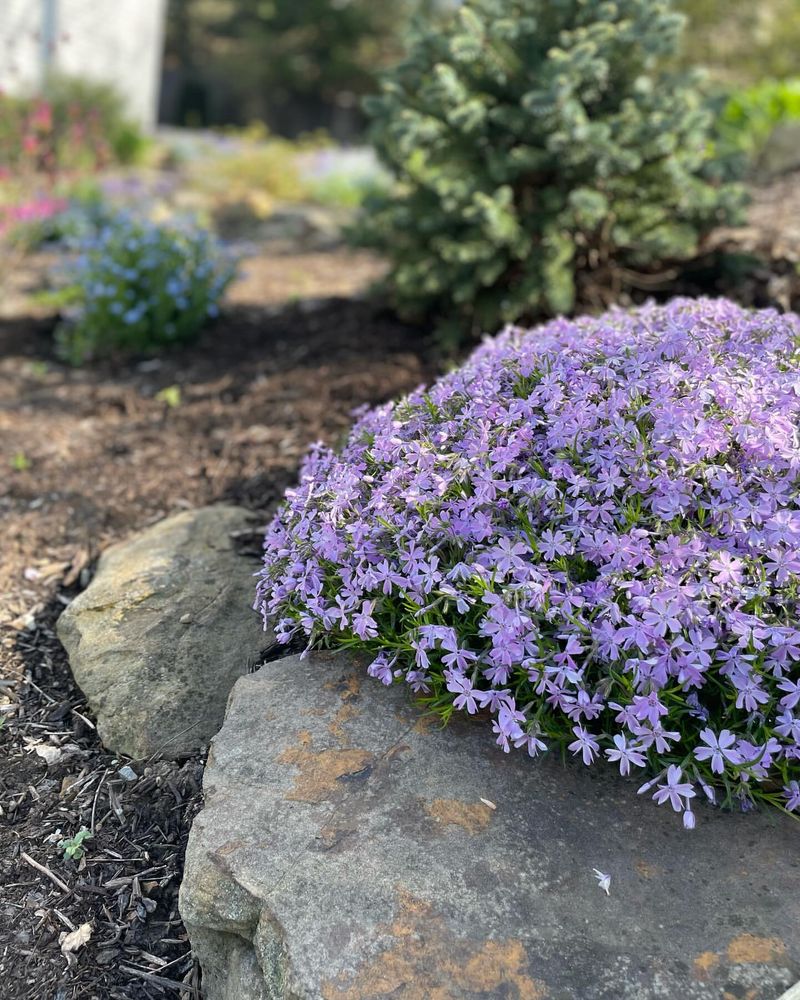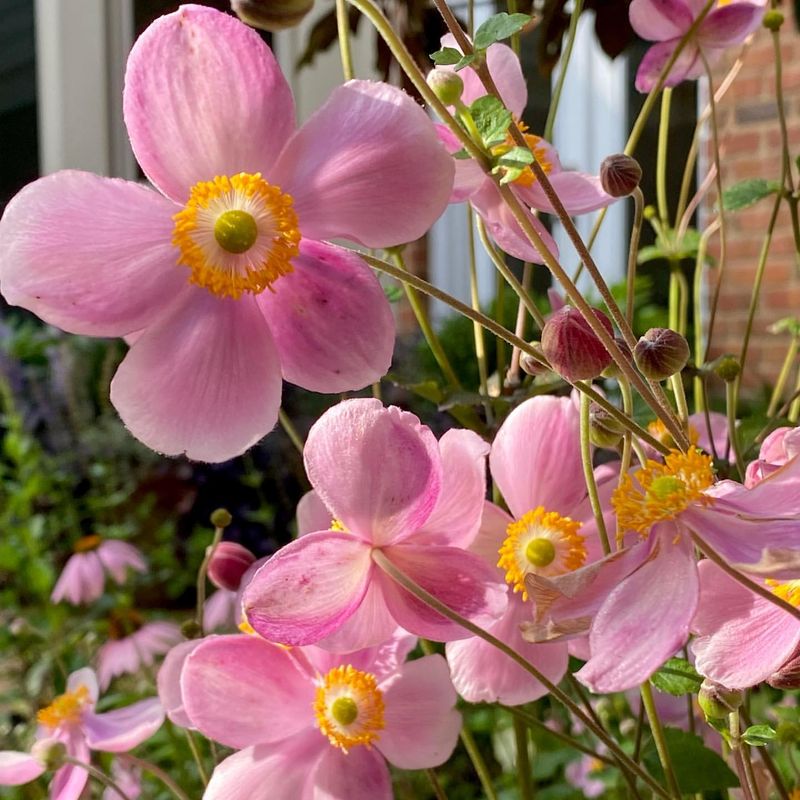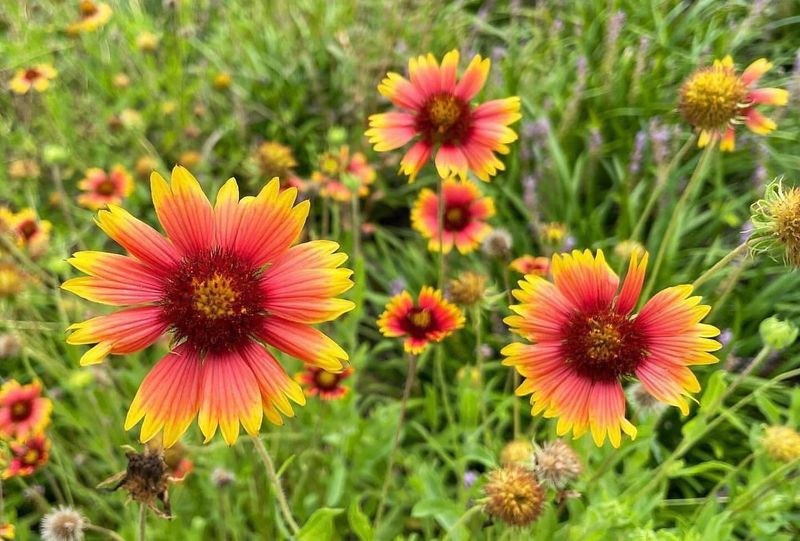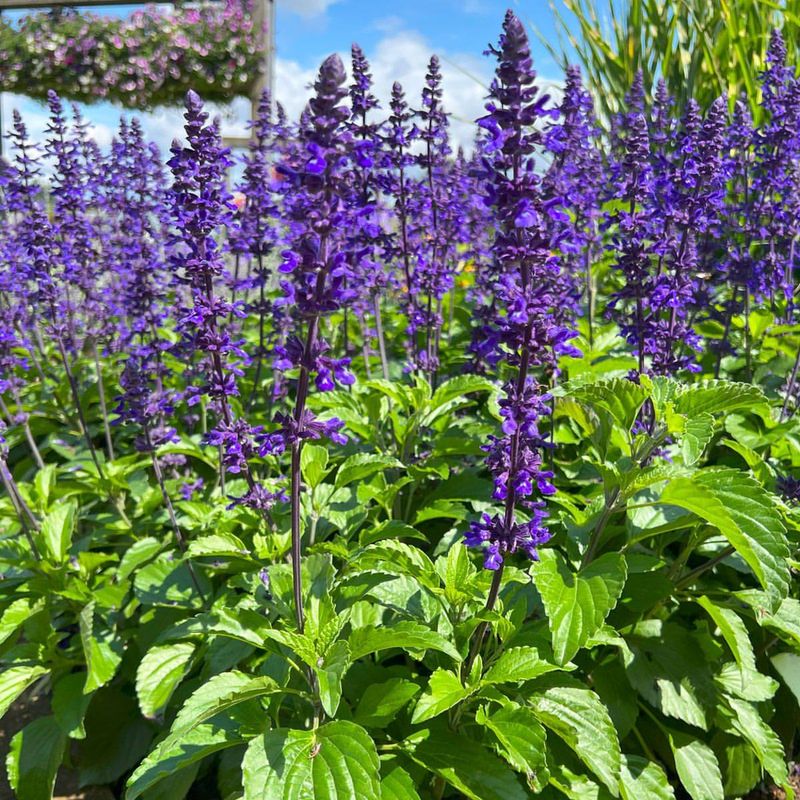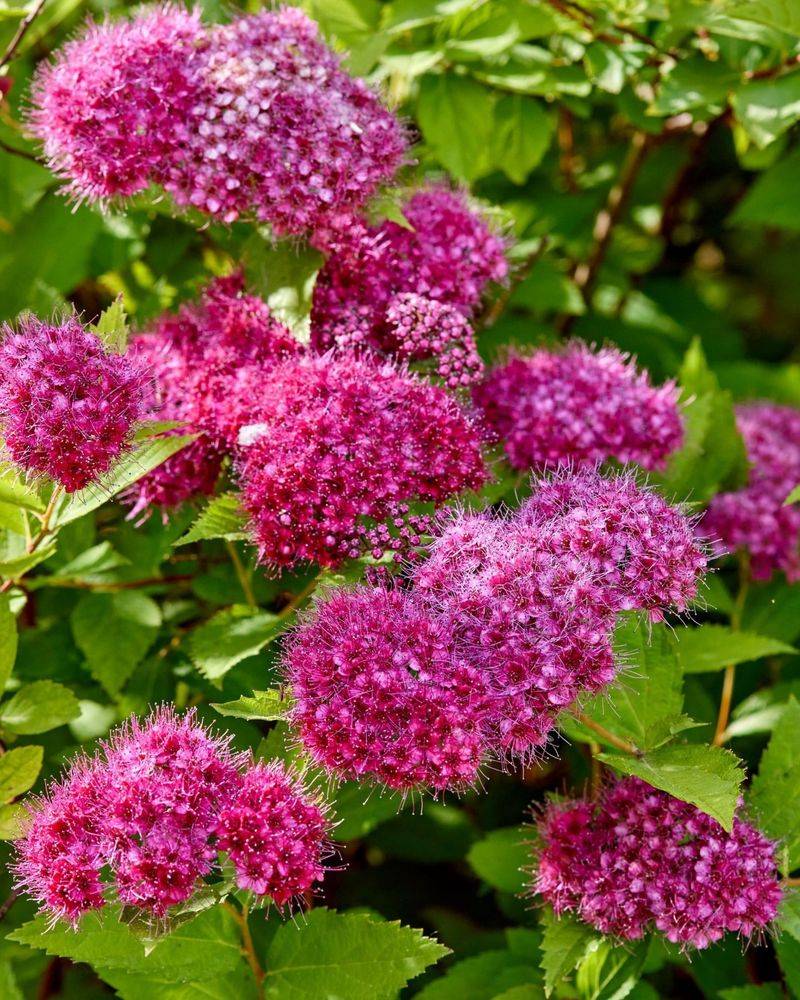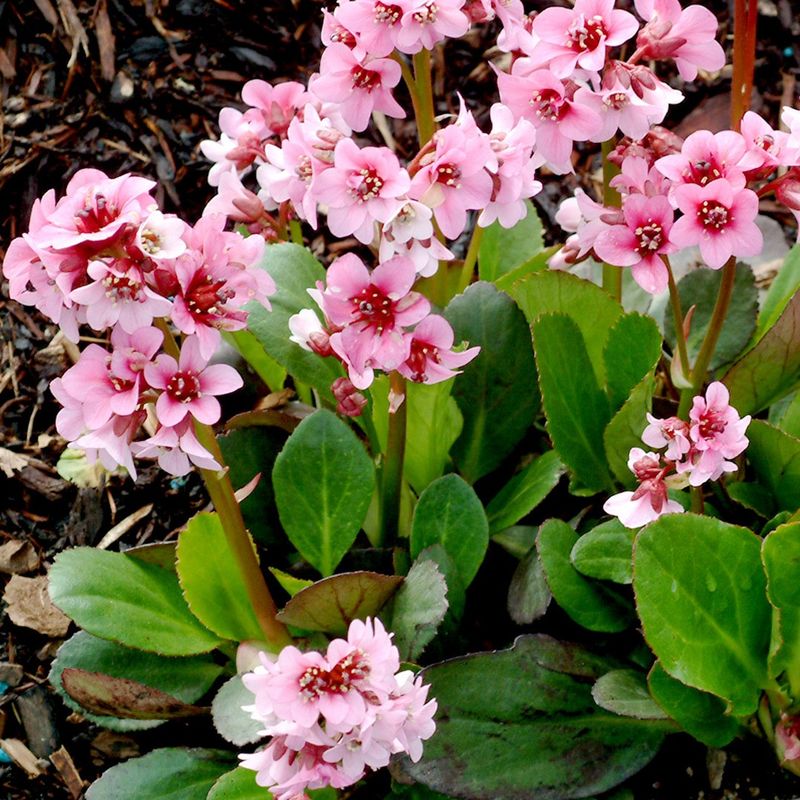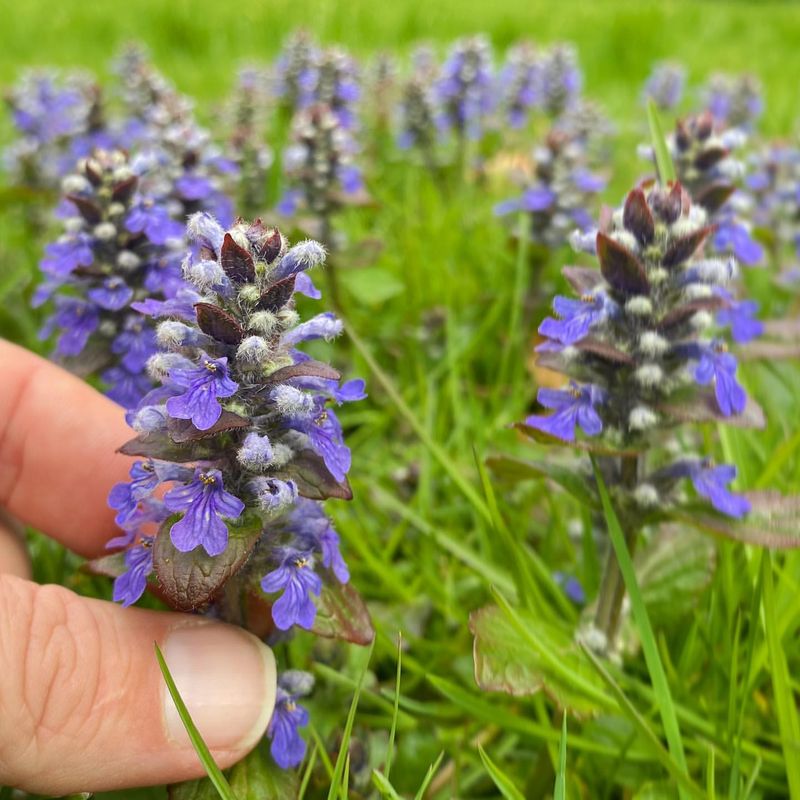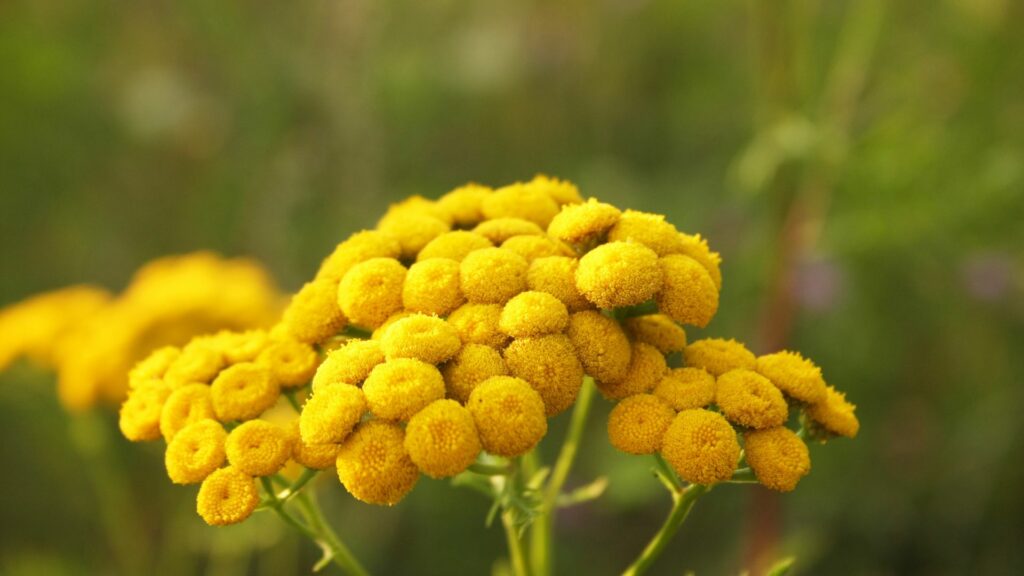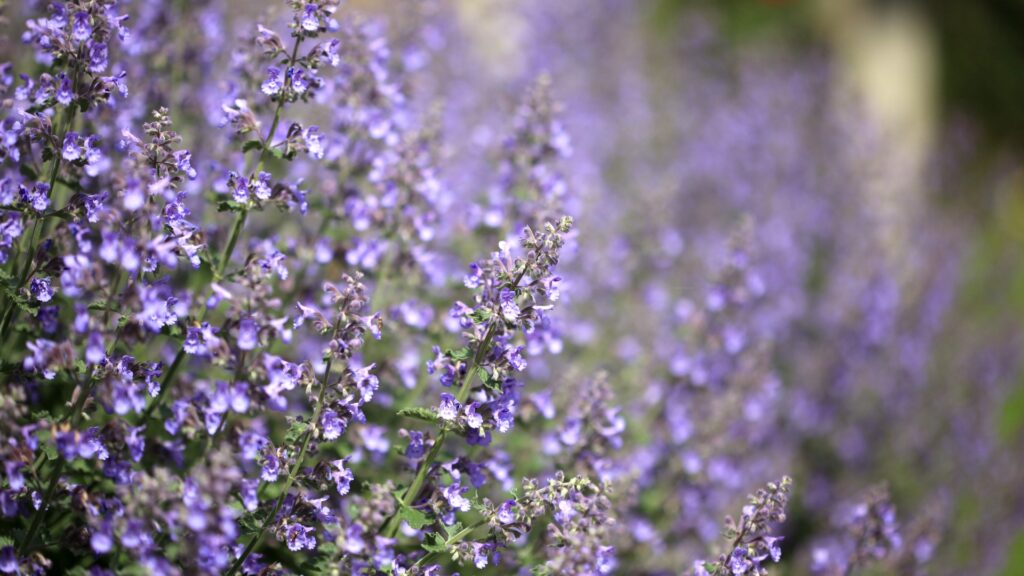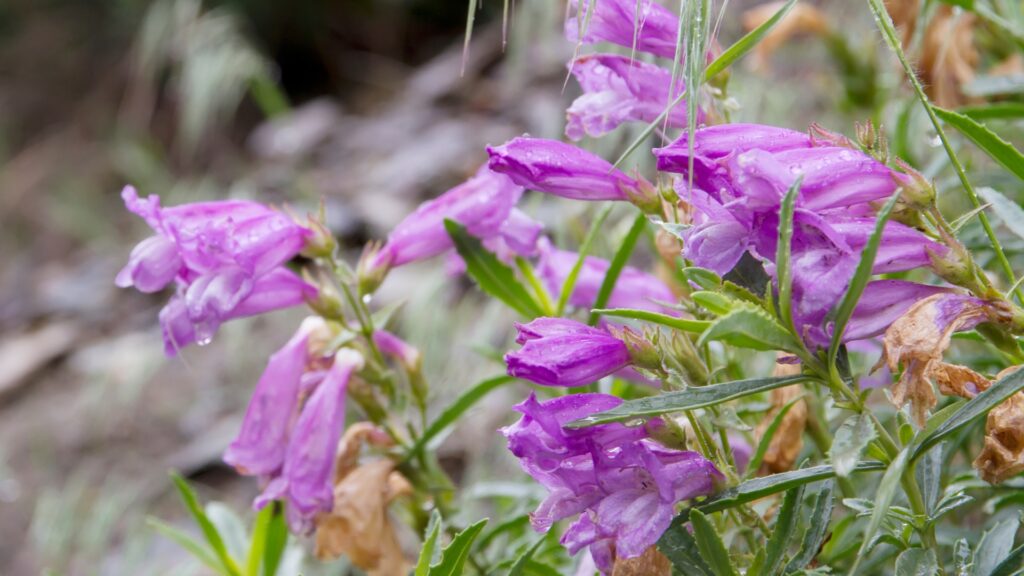Step into the colorful world of perennials—the true stars of gardens from coast to coast.
These plants don’t just survive—they thrive, bringing beauty and life to your space year after year. No matter your region, the right perennial can make your garden the envy of the neighborhood.
Here are 33 standout picks to keep your garden blooming like a pro.
1. Black-Eyed Susan
Let Black-Eyed Susan brighten your garden like sunshine in a pot! Known for its cheerful yellow petals and contrasting dark centers, this perennial is a staple in the Midwest. It’s as if the sun decided to plant a few of its rays right in your backyard.
Black-Eyed Susan is not just a pretty face; it’s a hardy bloomer that thrives in various conditions. Perfect for borders and meadows, they offer a low-maintenance beauty that lasts from midsummer to fall. Plus, their drought tolerance makes them a gardener’s BFF, especially during dry spells.
2. Lavender
Lavender is like the Swiss Army knife of perennials. Not only does it offer aromatic bliss, but its purple blooms are a sight to behold. Originating from the Mediterranean, Lavender has made itself at home in the western U.S., thriving in dry, sunny spaces.
With its distinctive scent, Lavender is perfect for creating a calming atmosphere. This perennial not only pleases the eyes and nose but is also a fantastic pollinator-friendly plant. Bees and butterflies can’t resist its charm, making it a must-have for eco-conscious gardeners.
3. Hosta
Hostas are the unsung heroes of shady gardens. Known for their lush foliage, these perennials bring a touch of elegance to any garden space. In the Northeast, where they thrive in the shade, Hostas are the perfect backdrop to highlight those sun-drenched blooms.
Hostas come in a variety of sizes and colors, turning your garden into a leafy wonderland. Whether your space is small or sprawling, there’s a Hosta for you. Their low-maintenance nature and ability to withstand cold winters make them a perennial favorite among gardeners.
4. Daylily
Daylilies are like the rock stars of the garden world. Known for their flamboyant, trumpet-shaped flowers, they come in a kaleidoscope of colors, ensuring your garden stays in the limelight. In the South, these perennials are the life of the party, blooming tirelessly throughout the summer.
Daylilies are not just about looks; they’re tough cookies too. They can handle heat and drought, making them ideal for those hot Southern climates. With minimal care, Daylilies will reward you with blooms that make even the sun blush.
5. Peony
Peonies are the beauty queens of the perennial garden, flaunting large, lush blooms that are as fragrant as they are fabulous. In the Northeast, they reign supreme, blooming from late spring to early summer.
These perennials are not just about good looks. Peonies are long-lived, often thriving for decades with minimal care. Their strong stems and vibrant flowers make them a standout choice for bouquets. Whether you’re planning a garden show or a simple backyard retreat, Peonies add a touch of elegance that’s hard to match.
6. Coneflower
Coneflowers bring a burst of color and charm to gardens across the Midwest. Their bright petals and spiky centers are a delight for both gardeners and pollinators. It’s as if Mother Nature decided to dot the landscape with little bursts of happiness.
These perennials are as tough as they are beautiful, thriving in a variety of soil conditions. Coneflowers are drought-resistant and low-maintenance, making them a favorite for those who want beauty without the fuss. Plus, they attract butterflies and bees, enhancing your garden’s ecosystem.
7. Shasta Daisy
Shasta Daisies are the epitome of cheerful elegance, bringing a classic touch to gardens in the western U.S. With their pure white petals and sunny centers, they seem to smile at passersby, inviting them to enjoy the simple beauty of nature.
These perennials are easy to grow and maintain, making them perfect for both novice and experienced gardeners. Shasta Daisies love the sun and thrive in well-drained soil. Their long-lasting blooms provide continuous joy from summer to early fall, ensuring your garden remains a delightful haven.
8. Bee Balm
Bee Balm is like the social butterfly of the garden, attracting hummingbirds, bees, and butterflies with its vibrant red and pink blooms. In the Northeast, this perennial is a favorite among pollinator-friendly gardens.
The aromatic foliage of Bee Balm adds another layer of appeal, with scents that are as inviting as its colors. It’s not just the pollinators that are drawn to Bee Balm; gardeners love it for its easy care and ability to thrive in various conditions. This perennial transforms any garden into a lively, buzzing paradise.
9. Sedum
Sedum, often known as stonecrop, is the darling of rock and dry gardens. With a variety of shapes and colors, Sedum adds texture and intrigue to any garden scene in the Midwest. It’s the kind of plant that plays well with others, complementing both flowers and foliage.
This perennial is as tough as nails, thriving in poor soil and drought conditions. Its fleshy leaves store water, making it a resilient choice for those who want a low-maintenance garden. Sedum’s late summer to fall blooms are a bonus, offering color when most other plants have tired out.
10. Coral Bells
Coral Bells, with their vibrant foliage, are the jazz musicians of the plant world, adding rhythm and harmony to shaded gardens. In the Southeast, these perennials are known for their colorful leaves that range from deep purples to bright greens.
Unlike many perennials that boast flowers, Coral Bells shine with their stunning foliage. They’re perfect for adding depth and interest to garden borders. Easy to care for, they thrive in shady spots and are a delight to gardeners seeking a splash of color without the hassle of too much maintenance.
11. Russian Sage
Russian Sage is the warrior poet of perennials. With its silvery foliage and spires of purple-blue flowers, it adds a touch of elegance to dry, sunny gardens in the West. It’s like a living piece of art swaying gently in the breeze.
This perennial is not just eye candy; it’s tough, thriving in poor, dry soils. Russian Sage is perfect for those who want beauty with minimal water use. Its aromatic leaves and long-lasting blooms make it a favorite for both gardeners and pollinators, ensuring a dynamic, bustling garden environment.
12. Astilbe
Astilbe is like the feather boa of the garden, offering a touch of drama and elegance with its feathery plumes. In the Northeast, it thrives in shady, moist areas, adding color and texture to those often-overlooked garden corners.
These perennials come in an array of colors, from soft pinks to vibrant reds, ensuring there’s an Astilbe for every garden palette. They require minimal care and are perfect for gardeners looking to add a bit of flair without extensive maintenance. Astilbes transform any shady spot into a vibrant, thriving oasis.
13. Hellebore
Hellebores, often called Lenten Roses, are the magicians of winter gardens, blooming when most plants are asleep. In the Southeast, these perennials bring color and life to the coldest months with their nodding, cup-shaped flowers.
Available in hues ranging from cream to deep purple, Hellebores add elegance to shaded garden areas. They are deer-resistant and low-maintenance, making them ideal for gardeners who prefer to watch the garden show unfold with minimal intervention. Hellebores are like the opening act of spring, heralding warmer days ahead.
14. Yarrow
Yarrow is the multitasker of the garden world, offering medicinal qualities and visual appeal with its flat-topped, bright yellow flowers. In the West, it thrives in dry, sunny areas, turning open fields into golden meadows.
This perennial is not just beautiful; it’s a natural insect repellent and attracts beneficial insects, making it a must-have for eco-conscious gardeners. Yarrow is easy to grow, requiring little care, and its drought-resistant qualities make it a favorite for those seeking a sustainable garden option that still packs a punch.
15. Bleeding Heart
Bleeding Hearts are like love letters from the garden, with their heart-shaped blooms that dangle like delicate charms. In the Northeast, these perennials add a touch of romance to shady, moist garden areas.
Despite their delicate appearance, Bleeding Hearts are surprisingly hardy, thriving in cool, shaded spots. They are perfect for gardeners looking to add a bit of whimsy and charm to their spaces. With minimal care required, Bleeding Hearts offer a unique beauty that captures the imagination and heart of all who pass by.
16. Lupine
Lupines bring a pop of color with their vertical spikes, making them the exclamation points of the garden. In the Midwest, these perennials thrive, standing tall and proud in meadows and borders.
With a palette that ranges from purple to pink and blue, Lupines offer a visual feast. They are nitrogen fixers, improving soil health while adding beauty. Easy to grow, Lupines are perfect for those who want to make a statement in their garden. Their striking appearance and beneficial nature make them a win-win for gardeners.
17. Foxglove
Foxgloves are the woodland royalty of the garden, with their stately spikes of bell-shaped flowers. In the Northeast, these perennials add a sense of grace and height to garden edges and woodland settings.
Available in hues of pink and purple, Foxgloves are perfect for creating a fairy-tale vibe. While their beauty is undeniable, they are also deer-resistant, providing both aesthetic and practical benefits. Foxgloves are ideal for gardeners looking to add a bit of drama and magic to their spaces without extensive care.
18. Iris
Irises are the artists of the garden, with their intricate flowers that look as if they’ve been painted by a master. In the Midwest, these perennials bring a splash of color and texture to sunny borders and beds.
Irises come in a variety of colors, but their blue and purple hues are particularly striking. They are easy to grow and care for, making them a favorite among beginners and experienced gardeners alike. With their elegant form and reliable blooms, Irises add a touch of class and creativity to any garden.
19. Lamb’s Ear
Lamb’s Ear is like the teddy bear of the garden, with its soft, fuzzy leaves that invite touch. In the West, this perennial thrives in sunny, dry conditions, adding a touch of whimsy to garden borders and paths.
Its silvery foliage is not just for looks; Lamb’s Ear is drought-tolerant and easy to care for, making it perfect for low-maintenance gardens. It’s also a great choice for children’s gardens, where its soft texture can be appreciated up close. Lamb’s Ear is a delight for gardeners seeking a tactile and visual addition to their spaces.
20. Hydrangea
Hydrangeas are the chameleons of the garden, known for their ability to change color based on soil pH. In the Southeast, these perennials thrive in shaded gardens, adding a pop of color with their large blooms.
From blue to pink to white, Hydrangeas offer a spectrum of colors that can be tailored to your garden’s palette. They are easy to grow and maintain, making them a favorite for gardeners who love bold, showy flowers. Hydrangeas bring a lush, full look to any garden, ensuring they remain the stars of the show.
21. Clematis
Clematis is the drama queen of vining plants, turning any garden structure into a floral spectacle. In the Northeast, these perennials adorn trellises and fences with their star-shaped blooms in dazzling colors.
This perennial is like nature’s wallpaper, transforming plain walls into vibrant displays. They are easy to care for, requiring only a bit of guidance to climb. Clematis is perfect for gardeners looking to add vertical interest and a splash of color to their outdoor spaces. With its fast growth and stunning blooms, it never fails to impress.
22. Coreopsis
Coreopsis is like the sunshine of the garden, with its bright yellow flowers that bring cheer to any space. In the Midwest, these perennials are known for their long-lasting blooms and low-maintenance nature.
With delicate, fern-like foliage, Coreopsis adds texture and lightness to garden beds. It’s a favorite among gardeners who want vibrant color without the fuss. These drought-tolerant plants flower all summer long, making them perfect for those who want continuous beauty. Coreopsis is an excellent choice for adding warmth and happiness to any garden.
23. Phlox
Phlox is the fragrant delight of the garden, with clusters of blooms that fill the air with their sweet perfume. In the Southeast, these perennials thrive in sunny, open spaces, adding a touch of romance and charm.
Available in a variety of colors, Phlox is perfect for creating a cottage-garden feel. They are easy to grow and maintain, making them ideal for those who love beautiful flowers with minimal effort. Phlox’s enchanting scent and vibrant blooms ensure that any garden becomes a fragrant, inviting retreat.
24. Japanese Anemone
Japanese Anemones are the elegant dancers of the garden, with their delicate flowers that sway gracefully in the breeze. In the Northeast, these perennials add a touch of refinement to garden beds and borders.
With blooms that range from pink to white, Japanese Anemones bring a subtle beauty that complements more vibrant plantings. They are easy to grow and care for, thriving in dappled shade. Perfect for those seeking a harmonious and tranquil garden space, Japanese Anemones offer a serene charm that captivates softly yet profoundly.
25. Gaillardia
Gaillardia, also known as Blanket Flowers, bring a fiesta of color to any garden with their vibrant red and yellow blooms. In the West, these perennials thrive in dry, sunny conditions, turning ordinary gardens into colorful celebrations.
These flowers are not only beautiful but also low-maintenance and drought-resistant, making them perfect for gardeners who want a lively display without the fuss. Gaillardia blooms continuously from early summer to fall, ensuring your garden remains a vibrant spectacle throughout the growing season.
26. Salvia
Salvia is like the conductor of the pollinator orchestra, with its spiky blooms that attract bees and butterflies. In the Midwest, these perennials are celebrated for their vibrant blue and purple flowers.
Salvia is easy to grow and maintain, thriving in sunny spots with well-drained soil. It’s a favorite for gardeners looking to support local ecosystems while enjoying a colorful display. With its long blooming period and minimal care requirements, Salvia ensures that both you and the local pollinators enjoy a harmonious garden symphony.
27. Spirea
Spirea is the versatile virtuoso of the garden, known for its ability to add beauty to a variety of landscapes. In the Southeast, these shrubs flourish, offering clusters of pink and white flowers that grace gardens with their delicate beauty.
Easy to grow and maintain, Spirea is perfect for borders, hedges, or as a standalone statement. They require minimal care, making them a favorite for gardeners who want effortless elegance. With their dense foliage and vibrant blooms, Spirea ensures your garden remains lush and inviting throughout the growing season.
28. Bergenia
Bergenia, also known as Elephant Ears, is the stalwart of shaded gardens, with its large, glossy leaves that add texture and interest. In the Northeast, this perennial thrives, adding a bold statement to garden paths and borders.
Bergenia is not just about foliage; its pink flowers add a splash of color in early spring. Easy to grow and maintain, Bergenia is perfect for gardeners seeking a reliable and attractive ground cover. Its ability to withstand cold temperatures and deer make it a practical choice for year-round beauty.
29. Ajuga
Ajuga, often called Bugleweed, is the stealthy ground cover that turns empty spaces into colorful displays. In the Southeast, these perennials thrive in shady areas, offering a carpet of deep purple foliage and blue flower spikes.
Ajuga is the perfect solution for those tricky spots where grass refuses to grow. It’s easy to care for and spreads quickly, making it ideal for gardeners who want lush coverage with minimal effort. With its vibrant colors and hardy nature, Ajuga transforms overlooked areas into beautiful, eye-catching displays.
30. Blazing Star
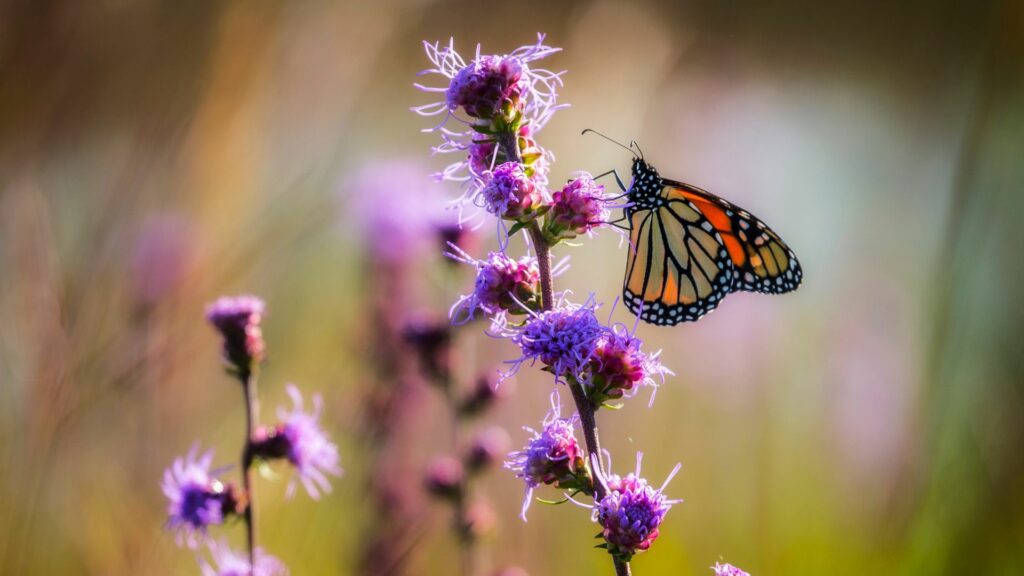
If you love unique, vertical blooms that attract pollinators, blazing star is a must-have.
This native prairie perennial produces tall spikes of fluffy, purple flowers that bloom from the top down, giving it a distinctive look. It thrives in full sun and well-drained soil, making it a fantastic choice for dry or sandy areas.
Butterflies, bees, and hummingbirds flock to it, and the grassy foliage stays attractive even after flowering.
31. Tansy
If you’re looking for a hardy, eye-catching perennial with a bit of wild charm, Tansy is a great choice. This plant grows up to 3 feet tall and features vibrant, yellow, button-like flowers that bloom in late summer.
Tansy thrives in full sun and well-drained soil, making it a perfect fit for Midwestern gardens. Not only does it attract pollinators like bees and butterflies, but its strong scent also helps repel pests like ants and mosquitoes.
It’s a tough, low-maintenance plant once established, though be aware it can spread quickly, so it’s best placed in areas where it has room to grow.
32. Catmint
Catmint is the laid-back jazz of the perennial world—cool, carefree, and always in tune with its surroundings. With soft, lavender-blue flowers and silvery foliage, this perennial brings a soothing rhythm to gardens in the Midwest and West, thriving in sunny, dry spots.
Not just a pretty face, Catmint is beloved by pollinators, especially bees, who can’t resist its mellow charm. It’s drought-tolerant and low-maintenance, making it perfect for gardeners who appreciate effortless beauty. Plus, its aromatic leaves deter deer and rabbits, giving you peace of mind along with gorgeous blooms from late spring through summer.
33. Penstemon
Penstemon, often called Beardtongue, is the adventurous spirit of the garden, flaunting tubular blooms in shades of pink, purple, red, and white. In the West and Southwest, this perennial thrives in rocky, well-drained soils, bringing a wild, rugged beauty to garden beds and borders.
Its striking flowers are a beacon for hummingbirds and bees, ensuring your garden buzzes with life. Penstemon’s upright growth habit and resilience to drought make it an ideal choice for xeriscapes or low-water gardens. With its bold colors and hardy nature, Penstemon offers a touch of the untamed landscape right in your backyard.

